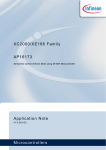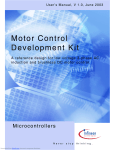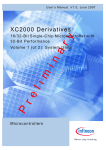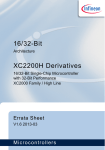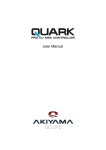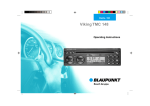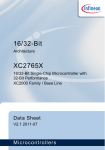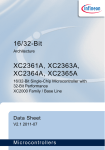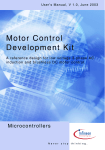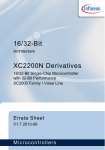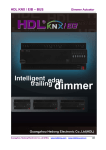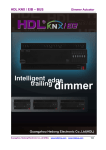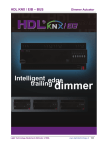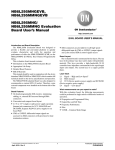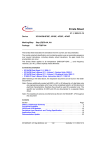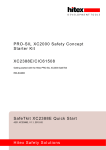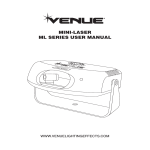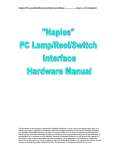Download XC2236N Drive Card Description
Transcript
XC2000 Family AP16179 XC2236N Drive Card Description Application Note V1.0, 2010-07 Microcontrollers Edition 2010-07 Published by Infineon Technologies AG 81726 Munich, Germany © 2010 Infineon Technologies AG All Rights Reserved. LEGAL DISCLAIMER THE INFORMATION GIVEN IN THIS APPLICATION NOTE IS GIVEN AS A HINT FOR THE IMPLEMENTATION OF THE INFINEON TECHNOLOGIES COMPONENT ONLY AND SHALL NOT BE REGARDED AS ANY DESCRIPTION OR WARRANTY OF A CERTAIN FUNCTIONALITY, CONDITION OR QUALITY OF THE INFINEON TECHNOLOGIES COMPONENT. THE RECIPIENT OF THIS APPLICATION NOTE MUST VERIFY ANY FUNCTION DESCRIBED HEREIN IN THE REAL APPLICATION. INFINEON TECHNOLOGIES HEREBY DISCLAIMS ANY AND ALL WARRANTIES AND LIABILITIES OF ANY KIND (INCLUDING WITHOUT LIMITATION WARRANTIES OF NON-INFRINGEMENT OF INTELLECTUAL PROPERTY RIGHTS OF ANY THIRD PARTY) WITH RESPECT TO ANY AND ALL INFORMATION GIVEN IN THIS APPLICATION NOTE. Information For further information on technology, delivery terms and conditions and prices, please contact the nearest Infineon Technologies Office (www.infineon.com). Warnings Due to technical requirements, components may contain dangerous substances. For information on the types in question, please contact the nearest Infineon Technologies Office. Infineon Technologies components may be used in life-support devices or systems only with the express written approval of Infineon Technologies, if a failure of such components can reasonably be expected to cause the failure of that life-support device or system or to affect the safety or effectiveness of that device or system. Life support devices or systems are intended to be implanted in the human body or to support and/or maintain and sustain and/or protect human life. If they fail, it is reasonable to assume that the health of the user or other persons may be endangered. AP16179 XC2236N Drive Card Description Device1 Revision History: V1.0 2010-08 Previous Version(s): V0.0 Page Subjects (major changes since last revision) – This is the first release … Trademarks TriCore® is a trademark of Infineon Technologies AG. We Listen to Your Comments Is there any information in this document that you feel is wrong, unclear or missing? Your feedback will help us to continuously improve the quality of this document. Please send your proposal (including a reference to this document) to: [email protected] Application Note 3 V1.0, 2010-07 AP16179 XC2236N Drive Card Description Table of Contents 1 Introduction . . . . . . . . . . . . . . . . . . . . . . . . . . . . . . . . . . . . . . . . . . . . . . . . . . . . . . . . . . . . . . . . . . . . . 5 2 2.1 Overview . . . . . . . . . . . . . . . . . . . . . . . . . . . . . . . . . . . . . . . . . . . . . . . . . . . . . . . . . . . . . . . . . . . . . . . 6 Drive Card Setup . . . . . . . . . . . . . . . . . . . . . . . . . . . . . . . . . . . . . . . . . . . . . . . . . . . . . . . . . . . . . . . . . 7 3 3.1 3.2 3.3 3.4 3.5 3.6 3.7 Hardware Description . . . . . . . . . . . . . . . . . . . . . . . . . . . . . . . . . . . . . . . . . . . . . . . . . . . . . . . . . . . . . 8 Power Supply . . . . . . . . . . . . . . . . . . . . . . . . . . . . . . . . . . . . . . . . . . . . . . . . . . . . . . . . . . . . . . . . . . . . 8 XC2236N . . . . . . . . . . . . . . . . . . . . . . . . . . . . . . . . . . . . . . . . . . . . . . . . . . . . . . . . . . . . . . . . . . . . . . . 8 User Interface . . . . . . . . . . . . . . . . . . . . . . . . . . . . . . . . . . . . . . . . . . . . . . . . . . . . . . . . . . . . . . . . . . . . 9 Digitally Isolated Debug Interface (JTAG, UART and CAN) . . . . . . . . . . . . . . . . . . . . . . . . . . . . . . . . . 9 Inverter Board Connection . . . . . . . . . . . . . . . . . . . . . . . . . . . . . . . . . . . . . . . . . . . . . . . . . . . . . . . . . 10 Hall Sensor and Encoder Interfaces . . . . . . . . . . . . . . . . . . . . . . . . . . . . . . . . . . . . . . . . . . . . . . . . . . 11 USIC Interface . . . . . . . . . . . . . . . . . . . . . . . . . . . . . . . . . . . . . . . . . . . . . . . . . . . . . . . . . . . . . . . . . . 11 4 PCB Layout . . . . . . . . . . . . . . . . . . . . . . . . . . . . . . . . . . . . . . . . . . . . . . . . . . . . . . . . . . . . . . . . . . . . 12 Application Note 4 V1.0, 2010-07 AP16179 XC2236N Drive Card Description 1 Introduction The Drive Card has been designed mainly for industrial applications. It is available for the XE166 family and the XC2000 family. This DriveCard supports XC2000 derivatives and as well all XE162 derivatives in a 64 Pin package. For simplicity reasons only XC2236N will be described in this document. XC2000 family - More performance, more Flash, better peripherals With more than 15 successful years in the microcontroller market place, C166 has set the standard for 16-bit architectures with the highest aggregate volume share of all available 16-bit devices. With its fast interrupt response and context switching, the C166 family is ideally suited for automotive, industrial, mass storage and wired as well as wireless communications applications. Compared with the XC166, XC2000 delivers more performance, more Flash memory, more RAM, strongly enhanced peripherals and a complete DSP library. MCU and DSP in a core Infineon Technologies Real Time Signal Controller combines the traditional strengths of a Microcontroller Unit (MCU) to control peripherals with the computing power of Digital Signal Processors (DSP). All in one enhanced XC2000 core. Together, the Microcontroller's real-time capability and ease of use and the DSP's mathematical performance and data throughput form a powerful singe-chip solution ideal for many embedded applications. For detailed technical information about the different derivatives please refer to the XC2000 family web pages on the Infineon Internet. http://www.infineon.com/XC2000 Application Note 5 V1.0, 2010-07 AP16179 XC2236N Drive Card Description 2 Overview The XC2236N DriveCard has been designed for motor control systems. It provides all signals necessary to drive a power inverter including feedback signals. Inverter Board Connector LED USIC POT XC2236N BSL Hall RST 5 LED kV Isolation LED OCDS JTAG Figure 1 CAN CAN XC2236N DriveCard This DriveCard, featuring the cost-effective 16-bit microcontroller XC2236N with 32-bit motor control performance, provides following interfaces: – – – – – – – USIC ASC/SSC/IIC: A synchronous serial interface like SPI, UART interface or IIC One Hall Interface can be used to directly connect hall sensors of a motor One Encoder Interface to directly connect encoder signals of a motor Digital isolated JTAG: Programming and debugging interface Digital isolated CAN: Controller Area Network e.g. for real-time monitoring and parameter setup Digital isolated UART: e.g. for real-time monitoring and parameter setup User interface: A POT and a LED can be used as user interface in stand alone operation The inverter board connector provides the following signals: – – – – Six PWM channels for 3-phase motor control (CAPCOM6E) Shut down signal for PWM channels (CTRAP) Enable signal for power inverter Seven ADC channels for fast analog signals such as DC-link current and phase voltages, as well as slow signals such as temperatures. – Timer 3 output latch signal – The power supply (5 V) for the drive card Application Note 6 V1.0, 2010-07 AP16179 XC2236N Drive Card Description 2.1 Drive Card Setup Although most of the programmable features of the XC2000 are selected by software either during the initialization phase or repeatedly during program execution, some features must be selected earlier because they are used for the first access of the program execution. These configurations are accomplished by latching the logic levels at a number of pins at the end of the internal reset sequence. Jumper 8 is used to configure the startup setting of the XC2000 during RESET. The default System Startup Configuration is shown in Table 1 below. All Jumper positions are OFF. The XC2000 executes a standard start from internal Flash. Table 1 Name in schematic Startup configuration Default configuration Description Startup configuration: Standard start from internal Flash (Default) JP8 1 2 3 Startup configuration: Standard UART Bootloader mode JP8 1 2 Note: For details about the UART Bootloader refer to the User Manual System Units. 3 Startup configuration: CAN Bootloader mode JP8 1 2 Note: For details about the CAN Bootloader refer to the User Manual System Units. 3 Note: For debugging purposes (OCDS) the standard start from internal Flash configuration must be used. Application Note 7 V1.0, 2010-07 AP16179 XC2236N Drive Card Description 3 Hardware Description 3.1 Power Supply The XC2236N DriveCard is supplied by two power supply domains. The main supply (VCC) is fed from the inverter board connector (see Chapter 3.5) and is connected to the MCU and all associated blocks. A second supply domain (VCCIO) exists for the digital isolation and the CAN transceiver. This can be provided via the CAN or the JTAG connector. Please refer to Chapter 3.4 for details. Two LEDs indicate the presence of these supply voltages. 3.2 XC2236N The XC2236N microcontroller is directly connected to dedicated interfaces. Next to the integrated current trimmed oscillator, an external resonator with 8 Mhz is available. A software download can be performed via JTAG, UART or CAN. For a UART or CAN download, the dedicated BSL (Boot Strap Loader) has to be set (see Chapter 2.1). For normal operation, the Jumper must be 'off'. A reset button is available to trigger a hardware reset. Figure 2 XC2236N Application Note 8 V1.0, 2010-07 AP16179 XC2236N Drive Card Description 3.3 User Interface There is a user interface available through a poti and a GPIO LED. The poti is connected to ADC0 channel 13, the LED is connected to port 10.13. A test pad is connected to this port as well in order to measure fast signals at an oscilloscope. Figure 3 User Interface: POTi and LED 3.4 Digitally Isolated Debug Interface (JTAG, UART and CAN) The XC2236N DriveCard is equipped with a digital isolation for JTAG, UART and the CAN interface. The 5 kV digital isolation, mainly designed for industrial applications, securely disconnects any debug, UART and CAN devices from the high voltage levels. As there is a separate power domain for the PC part of the XC2236N DriveCard, a 5 V power supply must be provided separately at VCCIO and GNDIO. LED1 indicates the availability of this supply domain. There is a DriveMonitor USB Stick available from Infineon Technologies that provides JTAG and CAN as well as the 5 V power supply in one device. Please refer to application note AP08071 for details. Figure 4 JTAG, UART and CAN: Debugger and Real Time Monitoring Interface Note: When a standard JTAG box is used, the VCCIO power supply must be provided at the CAN connector. Application Note 9 V1.0, 2010-07 AP16179 XC2236N Drive Card Description 3.5 Inverter Board Connection The standard 32-pin connector (DIN 41612, B/2) provides all signals needed for control of the 3-phase power inverter. The lowside (_L) and highside (_H) switches of the three power stages U, V and W are to be connected to the signals U_L, U_H, V_L, V_H, W_L and W_H. They are connected to the MCU’s CAPCOM6E peripheral CCU60, flexible and powerful PWM unit very well suited for motor control. A low signal at the CTRAP pins of the CAPCOM6E immediately switches all power stages in passive state and acts as an emergency shut-down for the inverter. All CAPCOM6E signals, including COUT63, are available at pin header JP1 for CCU60 An enable signal for the power stages can be provided via signal ENABLE Signals which are connected to the MCU’s GPIO port 10.11. Figure 5 Power Board Connector A 5 V power supply is expected at pins A1 and B1 of the inverter board connector in order to supply the MCU and peripheral components. A resistor and capacitor is placed near the connector to filter the power supply noise coming from the inverter board. The resistor R23 is soldered with a 0R and can be replaced if necessary with a other value or a ferrite bead. Application Note 10 V1.0, 2010-07 AP16179 XC2236N Drive Card Description 3.6 Hall Sensor and Encoder Interfaces The MCU provides a HALL sensor interfaces which can be accessed via JP4. Next to the HALL signals that are pulled up to VCC = 5 V, the VCC and GND signals are available as well The Encodeer Signals ENC_A and ENC_B are conected to the Timer 3 input. T3 operates in incremental interface mode automatically providing information on the sensor’s current position. These pins are overlayed with the CCPOS1A and CCPOS2A pins. In incremental interface mode, the two inputs associated with core timer T3 (T3IN, T3EUD) are used to interface to an incremental encoder. T3 is clocked by each transition on one or both of the external input pins to provide 2fold or 4-fold resolution of the encoder input. The Encoder_Top signal is connected to pin 2.1. With the ERU unit this pin can act like an external Interrupt request pin. . Figure 6 Hall Sensor Interfaces 3.7 USIC Interface The USIC0 Channel1 signals from the MCU are provided at JP7. This interface is connected directly to the MCU , and is therefore not isolated form the hot ground of the power inverter. The Interface can be used as ASC or SSC. The signals of JP7 can be mapped to GPIOs of the XC2236N as well. Figure 7 USIC Interface (SSC, ASC) Application Note 11 V1.0, 2010-07 AP16179 XC2236N Drive Card Description 4 PCB Layout Figure 8 Top view and Text Figure 9 Bottom view Figure 10 Solder view Application Note 12 V1.0, 2010-07 w w w . i n f i n e o n . c o m Published by Infineon Technologies AG














